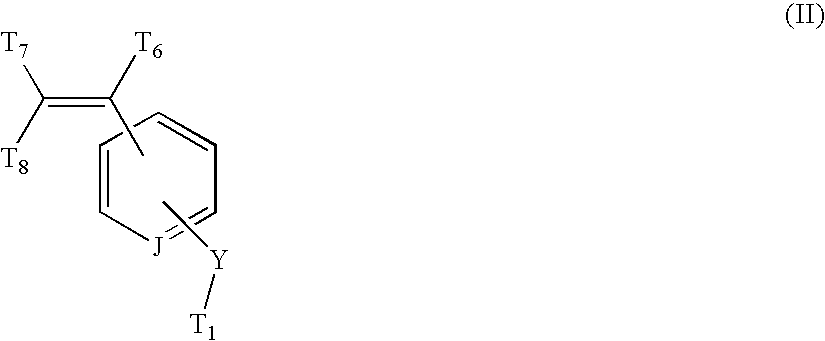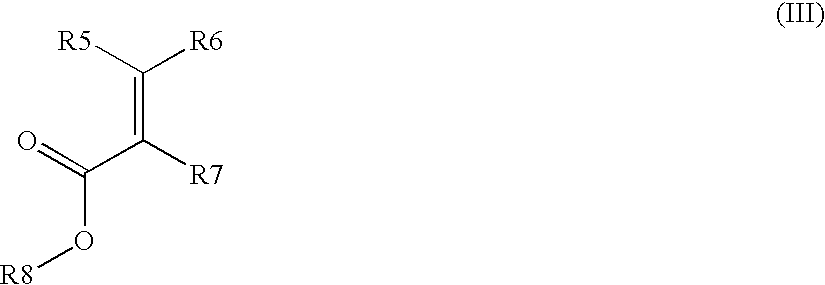Sunscreen and personal care compositions comprising a random terpolymer
a technology of terpolymer and sunscreen, which is applied in the direction of cosmetics, medical preparations, cosmetic preparations, etc., can solve the problems of skin disorders, actinic keratoses and carcinomas, uv-a ray damage or harm to the skin, etc., and achieves enhanced water stability and good stability
- Summary
- Abstract
- Description
- Claims
- Application Information
AI Technical Summary
Benefits of technology
Problems solved by technology
Method used
Image
Examples
example 1
Random Terpolymer
[0201]In a reaction flask with reflux condenser suitable for polymerization are dissolved in 9.86 g xylene and 4.93 g methoxypropyl acetate 2.84 g vinyl toluene, 4.55 g isobutyl methacrylate, 7.36 g 2-ethylhexyl acrylate, 5.20 g 2-hydroxyethyl methacrylate, 1.80 g polyethylene glycol monomethacrylate having a molecular weight of approximately 400 and 0.44 g ditertiary butyl peroxide. Polymerization is effected at the boiling point of the mixture while stirring and introducing an inert gas. At the end of the polymerization, 9.79 g isophorone diisocyanate are dissolved in 16.58 g isobutyl acetate and 16.58 g methoxypropyl acetate, and the remaining free NCO groups are then converted with 3.60 g polyethylene glycol monomethacrylate having a molecular weight of approximately 400 and 4.51 g 1-(3-aminopropyl)imidazole.
[0202]The solid content is then adjusted to 40% by weight with butylacetate.
[0203]According to formula (I), component M is vinyl toluene and y is 7.2 weight...
example 2
Random Terpolymer
[0204]In the manner comparable with Example 1, 3.54 g vinyl toluene, 5.69 g isobornyl methacrylate, 9.20 g 2-ethylhexyl methacrylate, 7.15 g hydroxy ethyl methacrylate, and 1.28 g ditertiary butylperoxide dissolved in 11.94 g xylene and 5.97 g methoxypropyl acetate are polymerized.
[0205]Subsequently, 12.23 g isophorone diisocyanate dissolved in 20.36 g butylacetate and 20.36 g methoxypropyl acetate are added. The remaining free NCO groups are then converted with 4.50 g polyethylene glycol monomethacrylate having a molecular weight of approximate 400 and 3.78 g 3-amino-1,2,4-triazole in 11.34 g N-methylpyrrolidone.
[0206]The solid content is then adjusted to 40% by weight with butylacetate.
[0207]According to formula (I), component M is vinyl toluene and y is 7.7 weight percent relative to the total weight of the terpolymer; component T is a mixture of isobornyl methacrylate and 2-ethylhexyl methacrylate and v is 32.3 weight percent relative to the total weight of the ...
example 3
Random Terpolymer
[0208]In the manner described in Example 1, 6.66 g isobornyl methacrylate, 5.46 g cyclohexyl methacrylate, 6.40 g n-butylacrylate, and 7.85 g 2-hydroxyethyl methacrylate are polymerized with 1.28 g ditertiary butyl peroxide dissolved in 11.98 g xylene and 5.99 g methoxypropyl acetate. To this polymer containing hydroxyl groups, 12.23 g isophorone diisocyanate dissolved in 20.4 g butylacetate and 20.40 g methoxypropyl acetate are added. The free NCO groups are then converted with 4.50 g polyethylene glycol monomethacrylate and 5.54 g 2-(2-pyridyl)-ethanol.
[0209]The solid content is then adjusted to 40% by weight with xylene.
[0210]According to formula (I), component T is a mixture of isobornyl methacrylate and cyclohexyl methacrylate and v is 24.9 weight percent relative to the total weight of the terpolymer; component D is polyethylene glycol monomethacrylate and u is 9.3 weight percent relative to the total weight of the terpolymer; component E is a mixture of 2-hyd...
PUM
| Property | Measurement | Unit |
|---|---|---|
| Fraction | aaaaa | aaaaa |
| Fraction | aaaaa | aaaaa |
| Fraction | aaaaa | aaaaa |
Abstract
Description
Claims
Application Information
 Login to View More
Login to View More - R&D
- Intellectual Property
- Life Sciences
- Materials
- Tech Scout
- Unparalleled Data Quality
- Higher Quality Content
- 60% Fewer Hallucinations
Browse by: Latest US Patents, China's latest patents, Technical Efficacy Thesaurus, Application Domain, Technology Topic, Popular Technical Reports.
© 2025 PatSnap. All rights reserved.Legal|Privacy policy|Modern Slavery Act Transparency Statement|Sitemap|About US| Contact US: help@patsnap.com



